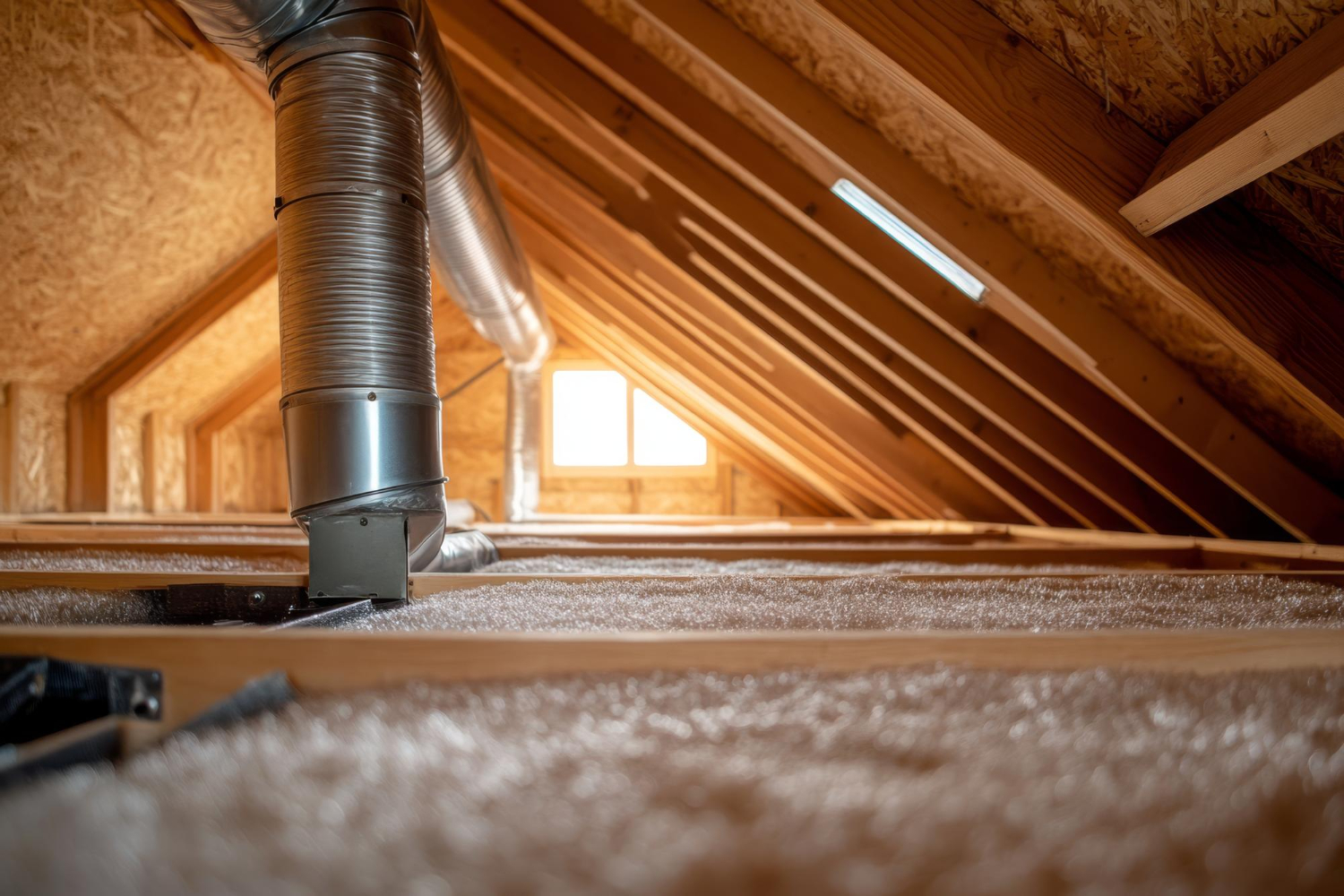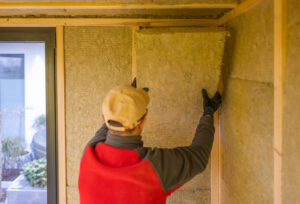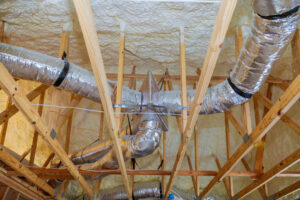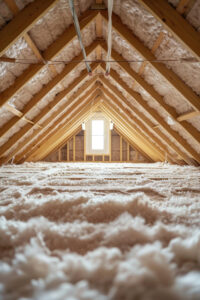Moisture control insulation is one of the most important defenses your home can have during the summer.
Summer brings unique moisture challenges that can impact your home’s health and efficiency. As temperatures rise, proper attic insulation becomes crucial for maintaining comfortable conditions and preventing damage.
When attic spaces aren’t properly insulated, excessive moisture can lead to mold growth, wood rot, and structural issues.
The right attic insulation works alongside a balanced ventilation system to control humidity levels and prevent moisture buildup in your home.
Adequate insulation creates a barrier that helps regulate temperature throughout your living spaces while keeping excess heat and moisture out of your attic. This protection is especially important during humid summer months when moisture problems tend to worsen.
We understand that managing home humidity can be frustrating, often requiring constant use of dehumidifiers.
By investing in proper attic insulation now, you can address the root cause of moisture problems rather than just treating the symptoms. This approach not only protects your home but can also reduce energy costs by improving your cooling system’s efficiency.
In this guide, we’ll show how insulation and attic ventilation work together to prevent costly water damage, improve indoor air quality, and create long-term energy savings.
Here’s what you need to know:
- How to tell if your attic insulation is causing moisture problems
- How moisture control insulation works in your attic
- Choosing the right attic insulation for moisture control
- Effective moisture control strategies for attics
- Benefits of proper attic insulation and moisture control
Good reading!
How to tell if your attic insulation is causing moisture problems
Moisture problems in the attic often go unnoticed until visible damage occurs, but the warning signs usually start earlier. Knowing what to look for can help you catch insulation-related moisture issues before they lead to costly repairs.
One of the most common indicators is musty odors coming from your ceiling or upper rooms. This smell is often the first hint that moisture is trapped in your insulation or that mold is forming out of sight. You may also notice increased humidity indoors, even if your home feels cool, or persistent condensation on upper-floor windows, especially in the mornings.
A visual inspection of your attic can reveal even more. If your insulation appears matted down, discolored, or damp to the touch, it’s likely been compromised by moisture. Look for dark patches on roof sheathing, peeling paint, or rust on nails or metal ductwork, all signs that condensation is occurring above the insulation layer.
You might also find that your HVAC system is working harder, with longer cycles and uneven cooling. That’s because wet or compacted insulation loses its thermal resistance (R-value), making it harder to regulate indoor temperatures and increasing energy use.
If you’re seeing any of these signs, your insulation may not just be underperforming, it could be contributing to a moisture cycle that risks your roof structure, air quality, and home comfort. A professional assessment can confirm whether replacement or targeted repairs are necessary.
How moisture control insulation works in your attic
Proper attic insulation serves as a critical defense against moisture problems in your home. It creates barriers that prevent warm, humid air from meeting cold surfaces where condensation can form.
The role of insulation in moisture management
Insulation acts as a protective barrier that helps manage moisture in several ways. First, it reduces temperature differences between your living space and the attic. When these temperature gaps are minimized, there’s less chance for condensation to form.
Quality insulation works with ventilation to create a balanced attic environment. Together, they allow moisture to escape rather than becoming trapped in your attic space.
Most importantly, insulation seals gaps and cracks where humid air might otherwise enter. By blocking these entry points with materials like spray foam, caulk, or weather stripping, you prevent moisture from reaching vulnerable areas.
When installed correctly, insulation creates a continuous thermal envelope around your home that keeps moisture-laden air from your living spaces from migrating into the attic.
Common causes and risks of attic moisture
Moisture in attics typically comes from everyday activities like cooking, showering, and even breathing. This humid air rises and, without proper barriers, enters the attic space.
Leaky roofs are another common source of attic moisture. Even small leaks can introduce significant amounts of water over time.
Poor ventilation traps this moisture, creating ideal conditions for mold growth. When moisture persists, it can lead to:
- Wood rot in structural elements
- Damaged or compressed insulation
- Mold and mildew growth
- Discoloration of building materials
These issues not only damage your home but can create serious health risks. Mold spores can trigger allergies, respiratory issues, and other health problems for your family.
Heat transfer, condensation, and mold formation
Warm air naturally holds more moisture than cold air. When warm, humid air from your living space rises and meets cold attic surfaces in winter, condensation forms – just like water droplets on a cold drink in summer.
This process happens most often around:
- Roof sheathing
- Attic joists and rafters
- Vent pipes and ductwork
- Areas with poor insulation
Once condensation forms, those damp surfaces become perfect breeding grounds for mold and mildew. Mold can begin growing in as little as 24-48 hours on wet surfaces.
Proper insulation prevents this cycle by maintaining more consistent temperatures. It keeps the warm, moist air from your living space from reaching cold attic surfaces where it would otherwise condense.
Adding attic fans can further help regulate temperature and humidity levels, working alongside insulation to create a drier, healthier attic environment.
Choosing the right attic insulation for moisture control
Selecting appropriate attic insulation is crucial for managing moisture levels in your home. The right materials and installation methods can prevent condensation, mold growth, and structural damage while improving energy efficiency.
R-value, vapor barriers, and air sealing for moisture control
R-value measures how well insulation resists heat flow. Higher R-values provide better thermal resistance. For effective moisture control, we recommend R-38 to R-60 in attics, depending on your climate zone.
Vapor barriers are essential components that prevent moisture from passing through your insulation. They should be installed on the warm side of the insulation in most climates. Remember that improper placement can trap moisture rather than block it.
Air sealing works hand-in-hand with insulation to control moisture. Before adding new insulation, seal all gaps around pipes, vents, and electrical fixtures. This prevents warm, moist air from entering the attic space and condensing on cooler surfaces.
Proper air sealing can reduce moisture transfer by up to 70% when done correctly. Use caulk for small gaps and expanding foam for larger openings.
Comparing insulation materials: Fiberglass, cellulose, and spray foam
Fiberglass insulation is available as batts or blown-in material. It’s cost-effective but can absorb moisture, reducing its effectiveness over time. Fiberglass batts have an R-value of 2.9-3.8 per inch.
Cellulose insulation is made from recycled paper and treated with borate for fire and pest resistance. It fits well around obstacles and has an R-value of 3.2-3.8 per inch. Cellulose can hold moisture but also allows it to dry out relatively quickly.
Spray foam insulation offers superior moisture control. Closed-cell spray foam acts as both insulation and vapor barrier with an R-value of 6-7 per inch. It creates an airtight seal but costs 2-3 times more than fiberglass or cellulose.
| Insulation Type | R-Value Per Inch | Moisture Resistance | Cost |
| Fiberglass | 2.9-3.8 | Low to Moderate | $ |
| Cellulose | 3.2-3.8 | Moderate | $$ |
| Spray Foam | 6-7 (closed-cell) | Excellent | $$$ |
Sustainable insulation choices for long-term moisture control
Eco-friendly insulation options include recycled cotton, wool, and cellulose. These materials have smaller carbon footprints compared to fiberglass and spray foam.
Cellulose stands out as particularly environmentally friendly since it’s made from up to 85% recycled newspaper and requires less energy to manufacture than fiberglass. It also creates a tighter seal against air movement.
When considering long-term savings, higher upfront costs often translate to better performance. Spray foam may cost more initially but can save money through reduced energy bills and potential moisture damage prevention.
We also recommend combining insulation types for optimal performance. For example, using spray foam for air sealing critical areas, then adding less expensive blown-in cellulose or fiberglass to reach desired R-values.
Proper ventilation systems working alongside your insulation will further enhance moisture control. Soffit vents and ridge vents create natural airflow that helps keep your attic dry.
Effective moisture control strategies for attics
Controlling attic moisture requires a comprehensive approach that addresses ventilation, air leaks, and proper installation techniques. Proper moisture management not only protects your roof structure but also improves your home’s overall energy efficiency.
How attic ventilation helps prevent moisture issues
Good ventilation is essential for removing excess moisture from your attic space. A balanced ventilation system typically includes both intake vents (soffit vents) and exhaust vents (ridge vents or gable vents). This combination creates natural airflow that helps push humid air out of the attic.
Ridge vents installed along the peak of the roof work with soffit vents to create continuous air movement. This passive ventilation system uses the stack effect—warm air rises and exits through the ridge vent while cooler air enters through the soffit vents.
For larger attics, we recommend maintaining a ratio of 1 square foot of ventilation for every 300 square feet of attic space. This ensures adequate air exchange to prevent moisture buildup.
In high-humidity climates, mechanical ventilation like attic fans may be necessary to supplement natural airflow, especially during particularly humid seasons.
Air leaks and sealing attic bypasses
Attic bypasses are hidden passages where warm, moist air from your living space escapes into the attic. Common air leak points include gaps around plumbing vents, electrical boxes, recessed lighting, and the top plate of interior walls.
Sealing these bypasses is crucial for moisture control. We recommend using appropriate materials like caulk for smaller gaps and spray foam insulation for larger openings. Pay special attention to sealing around chimney penetrations and bathroom vent ducts.
Air leakage not only brings moisture into your attic but also creates cold spots where condensation can form. A professional blower door test can help identify hard-to-find leaks that contribute to moisture problems.
Remember that up to 50% of the air in your home may come from your attic, making air sealing a vital step in controlling indoor humidity levels.
Fixing poor attic ventilation and insulation mistakes
Poor ventilation often results from blocked soffit vents, insufficient vent area, or improperly installed insulation that covers intake vents. We recommend installing proper vent baffles to maintain an open airway from soffits to the attic space.
Insulation issues like compressed batts or gaps between insulation sections can create cold zones where condensation forms. Proper installation techniques include ensuring even coverage and appropriate depth throughout the attic floor.
Water leaks from the roof should be addressed immediately. Even small leaks can introduce significant moisture into the attic environment over time. Regular inspections of your attic space, especially after storms, can help identify potential issues before they cause serious damage.
Maintaining a consistent humidity level inside your home (30-50%) also helps reduce moisture migration to the attic. Using bathroom and kitchen exhaust fans that vent properly to the outside—not into the attic—is essential for managing indoor humidity.
Benefits of proper attic insulation and moisture control
Proper attic insulation serves as a critical barrier against moisture problems while providing numerous benefits for your home. It creates a protective shield that maintains indoor comfort and protects your investment.
Enhanced energy efficiency and savings
Well-insulated attics significantly reduce energy consumption throughout your home. When moisture levels are controlled, your insulation performs at its peak efficiency, preventing heat loss during winter and keeping cool air inside during summer. This balance directly impacts your energy bills.
We’ve found that homeowners can save 15-20% on heating and cooling costs with proper attic insulation. These savings typically provide a strong return on investment within 3-5 years of installation.
According to the U.S. Environmental Protection Agency (EPA), properly insulating and air sealing your home can reduce heating and cooling costs by an average of 15%, while also improving overall comfort and humidity control.
Your HVAC systems don’t need to work as hard when your attic is properly insulated. This reduces energy consumption and extends the life of these expensive systems.
Proper insulation acts as a thermal barrier that stabilizes indoor temperatures. This creates more consistent comfort throughout your home and fewer temperature fluctuations between floors.
How moisture control insulation protects health and structure
Excessive moisture in your attic can lead to serious structural problems. Proper insulation helps control humidity levels, preventing condensation that can damage building materials.
Without adequate insulation, moisture can cause wood rot in roof sheathing and other structural components. This weakening can lead to costly repairs that far exceed the price of proper insulation.
Ice dams form when heat escapes through poorly insulated attics, melting snow that later refreezes. These ice formations can damage roofing materials and allow water to seep into your home.
Controlling moisture also prevents mold growth. This protection is vital for maintaining good indoor air quality and preventing respiratory issues for your family.
Professional versus DIY insulation installation
Professional attic insulation installation ensures proper coverage and moisture barriers. Experts identify potential problem areas that DIY installers might miss, such as ventilation issues or existing moisture damage.
While DIY installation may seem cost-effective initially, lack of experience can lead to gaps in coverage. These gaps become weak points for moisture intrusion and energy loss.
Professional installers use specialized equipment to reach difficult areas. They also select the right insulation materials for your specific climate conditions and moisture concerns.
The cost difference between professional and DIY installation often pays for itself through better performance. Professionals typically offer warranties on both materials and workmanship, providing peace of mind.
Conclusion
Moisture control insulation does more than keep your home cool, it protects the structure, the air you breathe, and the systems that keep your house running. When your attic is poorly insulated or lacks airflow, summer humidity doesn’t just make things uncomfortable; it quietly invites mold, rot, and rising energy bills.
But with the right insulation, air sealing, and ventilation working together, your attic becomes a barrier, not a liability. You stabilize indoor temperatures, protect your roof and framing, and relieve your HVAC system from overwork.
These aren’t just seasonal benefits, they’re long-term upgrades that reduce maintenance costs, improve air quality, and make your home more resilient against extreme weather.If your home struggles with humidity or attic heat during the summer, it’s time to take action. Contact Terrain Insulation today for a moisture control insulation assessment, and start protecting your home from the top down.





